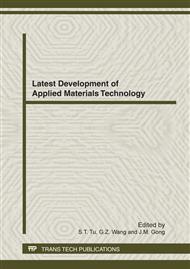[1]
C.S. Ray, S.T. Reis, R. K. Brow, W. Höland , V. Rheinberger, A new DTA method for measuring critical cooling rate for glass formation, Journal of Non-Crystalline Solids.351 (2005) 1350-1358.
DOI: 10.1016/j.jnoncrysol.2005.03.029
Google Scholar
[2]
D.R. Uhlmann, H. Yinnon, Glass science and technology (Chapter 1), in: D.R. Uhlmann, N.J. Kreidl (Eds.), Glass Forming Systems, vol. 1, Academic, New York, NY, 1983.
Google Scholar
[3]
D.R. Uhlmann, A kinetic treatment of glass formation, Journal of Non-Crystalline Solids.7 (4) (1972) 337-348.
DOI: 10.1016/0022-3093(72)90269-4
Google Scholar
[4]
N. Yodoshi, A. Miura, W. Dong, A. Kawasaki,Synthesis of Mono-Sized Fe-Co Based Metallic Glass Particles by Pulsated Orifice Ejection Method, J. Jpn. Inst. Metals.72 (2008) 686-692.
DOI: 10.2320/jinstmet.72.686
Google Scholar
[5]
A. Miura, W. Dong,M. Fukue, Preparation of Fe-based monodisperse spherical particles with fully glassy phase, Journal of Alloys and Compounds. 509(2011) 5581-5586.
DOI: 10.1016/j.jallcom.2011.02.044
Google Scholar
[6]
A. Inoue, B.L. Shen, C.T. Chang,Super-high strength of over 4000 MPa for Fe-based bulk glassy alloys in [(Fe1−xCox)0.75B0.2Si0.05]96Nb4 system, Acta Mater. 52(2004) 4093-4099.
DOI: 10.1016/j.actamat.2004.05.022
Google Scholar
[7]
A. Inoue, Advanced Technology and Application of Nano Metals, CMC Publishing Co., Ltd., (2003).
Google Scholar
[8]
C.R.M. Afonso, C. Bolfarini, W.J. Botta Filho, C.S. Kiminami, Spray forming of glass former Fe63Nb10Al4Si3B20 alloy, Material Science and Engineering A. 449-451(2007), 884-889.
DOI: 10.1016/j.msea.2006.02.393
Google Scholar
[9]
V.C. Srivastava, K.B. Surreddi, S. Scudino, M. Schowalter, V. Uhlenwinkel, Microstructure and mechanical properties of partially amorphous Al85Y8Ni5Co2 plate produced by spray forming, Material Science and Engineering A. 527(2010), 2747-2758.
DOI: 10.1016/j.msea.2010.01.057
Google Scholar
[10]
S. Masuda, T. Takagi, W. Dong, Solidification Behavior of Falling Germanium Droplets Produced by Pulsated Orifice Ejection Method, Journal of Crystal Growth.310 (2008), 2915-2919..
DOI: 10.1016/j.jcrysgro.2008.01.050
Google Scholar
[11]
W. Dong, S. Masuda, K. Takagi, The Development of Mono-sized Micro Silicon Particles for Spherical Solar Cells by Pulsated Orifice Ejection Method, Materials Science Forum.534-536 (2007), 149-152.
DOI: 10.4028/www.scientific.net/msf.534-536.149
Google Scholar
[12]
Netsubusseigakkai,Thermophysical Properties Handbook, Youkendou, Tokyo, 2000.
Google Scholar
[13]
The Japan Institute of Metal, Kinzoku Data Book, vol.3, Maruzen Co. Ltd., Tokyo, 1993.
Google Scholar
[14]
P. F. Paradis, T. Ishikawa, S. Yoda,Non-contact measurements of thermophysical properties of niobium at high temperature,J. Mater. Sci. 36(2001), 5125-5130.
Google Scholar
[15]
S. Taniguchi, J. Yagi,Transport Phenomena in Materials Engineering, Tohoku University Press, Japan, 2001.
Google Scholar


